PIARC publications from 2024 - 2027 work cycle
This page presents the technical reports of the 2024-2027 work cycle of PIARC (World Road Association). They are available in one or more of the three working languages of the Association which are French, English and Spanish and have been published after a meticulous validation and quality control exercise.
These reports will be published as they are drafted by our Technical Committees, which work according to the objectives set out in the Strategic Plan 2024 - 2027. Reports from the previous work cycle are available on this page.
This follows the structure of the 2024 - 2027 Strategic Plan.
- Strategic Theme 1 - Road Administration
- Strategic Theme 2 - Road Mobility
- Strategic Theme 3 - Safety and Sustainability
- Strategic Theme 4 - Resilient Infrastructure
- PIARC Special Projects
PIARC publishes numerous technical reports, which are reference documents that are widely used in the road and transport sectors. They complement other publications of the Association such as the Routes / Roads magazine, Proceedings of international congresses, Proceedings of international seminars and online Manuals.
These technical reports are the output of the work of over 1,000 experts during a four-year work cycle. Their involvement and professionalism must be underlined. They are mobilized within Technical Comittees or Task Forces as defined by the Strategic Plan, which structures the activities of the Association and aims to meet the expectations and needs of road administrations and operators and all members of the Association. These reports thus constitute a wealth of information, made available to all. They offer state of the art international best practices on roads and road transport in a context of integrated and sustainable development.
These technical reports are available free of charge as part of the knowledge sharing and dissemination mission that guides the Association. All language versions are presented simultaneously here, to take into account the reading preferences of each user.
Strategic Theme 1 - Road Administration
TC 1.1 Performance of Transport Administrations
-
Envisioning The Transport Agency Of The Future - A PIARC Literature Review

Over the last decade, there have been unprecedented changes impacting the roads and transport sector with the rise of new technologies and service models, climate change, new forms of work and leisure, and the evolution of a complex and technology-enabled mobility ecosystem at a fast pace. This creates a context of the sector facing important challenges originating from systemic and ongoing changes in society, economy and environment. Transportation agencies must keep on track of these trends while [...]
-
Envisioning the Transport Agency of the Future - A PIARC High Impact Summary

Over the last decade, there have been unprecedented changes impacting the roads and transport sector with the rise of new technologies and service models, climate change, new forms of work and leisure, and the evolution of a complex and technology-enabled mobility ecosystem at a fast pace. This creates a context of the sector facing important challenges originating from systemic and ongoing changes in society, economy and environment. Transportation agencies must keep on track of these trends while [...]
-
Envisioning the Transport Agency of The Future – State of Knowledge
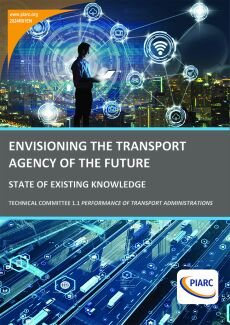
Over the last decade, there have been unprecedented changes impacting the roads and transport sector with the rise of new technologies and service models, climate change, new forms of work and leisure, and the evolution of a complex and technology-enabled mobility ecosystem at a fast pace. This creates a context of the sector facing important challenges originating from systemic and ongoing changes in society, economy and environment. Transportation agencies must keep on track of these trends while [...]
TC 1.2 Contribution of Roads to Economic and Social Development
TC 1.3 Finance and Procurement
TC 1.4 Planning the Resilience of Road Networks - Climate Change and other Hazards
TC 1.5 Disaster Management
-
Challenges In Resilience Building For Road Disaster Management Coordination And Cooperation In Different Regions - Summary of PIARC & REAAA Joint Session at the IARC Osaka Workshop, May 2025

The international workshop was organized by the World Road Association (PIARC) through its Technical Committee 1.5, "Disaster Management," and the Japan Road Association (JARA). The Road Engineering Association of Asia and Australasia (REAAA) collaborated with the event through its Climate Change, Resilience, and Disaster Management Committee. The workshop theme was "Road Disaster Management: Enhancing Coordination, Cooperation, and Diversity". This event provided information on the latest disaster [...]
-
Ensuring the Network Remains Operational during Unprecedented Conditions - Proceedings from Piarc Panel Discussion at Highways UK in October 2024
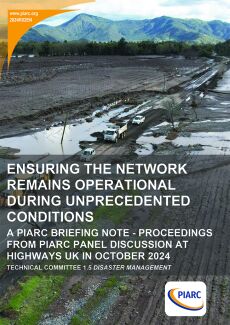
Members of PIARC TC 1.5 Disaster Management from across the globe were asked to present and participate in a panel discussion at Highways UK in October 2024 : “PIARC Disaster Management Committee Panel: Ensuring the network remains operational during unprecedented conditions.” Highways UK is a major event for the highways and transportation industry in the UK that provides a conference, exhibition, and networking opportunities. This briefing note provides details on the thought provoking, [...]
Strategic Theme 2 - Road Mobility
TC 2.1 Roads for Accessibility and Mobility in Urban and Periurban Areas
TC 2.2 Roads for Equity, Accessibility and Mobility in Rural and Interurban Areas
TC 2.3 Sustainable Freight
TC 2.4 Road Network Operations and ITS for Sustainability
TC 2.5 Road infrastructure for Connected and Automated Mobility
Strategic Theme 3 - Safety and Sustainability
TC 3.1 Road Safety
TC 3.2 Winter Service
TC 3.3 Asset Management
TC 3.4 Environmental Sustainability of Road Infrastructure and Transport
TC 3.5 Road infrastructure for road transport decarbonization
Strategic Theme 4 - Resilient Infrastructure
TC 4.1 Pavements
-
Measures for Reducing Carbon Footprint of Pavements - A PIARC Collection of Case Studies

This report contains a collection of case studies on measures to reduce the carbon footprint of pavements, leveraging the collective expertise and efforts of the authors, including contributions from experts worldwide, including from low and middle-income countries. The case studies include the various stages of emissions of the materials across their life cycle, including the Product Stage (A1-A3), Construction Stage (A4-A5), Use Stage (B1-B7), End of Life Stage (C1-C4), and reuse, recovery [...]
-
Low-Cost Pavement Systems
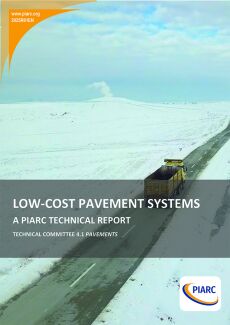
This report presents the benefits of low-cost pavements to agencies and their challenges, based on real-life examples. It offers a methodology that can be adapted by the user to specific conditions or used as is with the suggested parameters. Low-Cost Pavement Systems are defined as infrastructure solutions for road surfaces designed to minimize initial construction expenses and ongoing maintenance costs while ensuring adequate performance and durability. A Low-Cost Pavement System should ensure [...]
TC 4.2 Bridges
TC 4.3 Earthworks
TC 4.4 Tunnels
-
Sustainability of Tunnel Operation: New Approaches - A PIARC Briefing Note And Collection Of Case Studies

Sustainability means creating a new economic and social model that can respond to today’s environmental challenges. Applied to road tunnels, this concept includes the environmental aspects of reducing energy consumption and emissions, and minimising impacts over the tunnel’s full life cycle. The economic aspects of modern road tunnels focus on keeping costs under control over time, supporting innovation, and helping create local jobs. Ultimately, the social aspects, which are about making tunnels [...]
TC 4.5 Decarbonization of Road Construction and Road Maintenance
TC 4.6 Road Design Standards
PIARC Special Projects
-
Motorcycle Protection Systems & Safety Aspects Of Management Of Traffic For Motorcycles - A PIARC Special Project

This document is the outcome of the PIARC Special Project on Motorcycle Protection Systems and Safety Aspects of the Management of Traffic for Motorcycles, conducted under the framework of the PIARC Strategic Plan 2024–2027. The study was initiated by the World Road Association (PIARC) in response to the continuing global challenge of improving the safety of powered two-wheeler users, who remain one of the most vulnerable groups of road users worldwide. The content of this report has been prepared [...]
-
Management of Road Worksites - Special Project

This PIARC Special Project was commissioned to address a critical and escalating global challenge: the growing safety, mobility, and environmental burden of road worksites. Driven by the dual pressures of maintaining ageing infrastructure in established economies and unprecedented network expansion in developing regions, roadwork activity is outpacing traffic growth, and worksites have become a disproportionate source of road trauma, with the impacts felt most severely in low- and middle-income [...]
-
Artificial Intelligence in the Road Sector
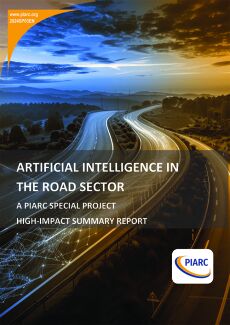
Artificial Intelligence (AI) is emerging as a transformative force in the road sector, offering substantial opportunities to improve safety, efficiency, and sustainability. Commissioned under PIARC's Special Projects programme, this study carried out by Roughan & O'Donovan Ltd., provides a comprehensive assessment of AI's current and future role in road infrastructure planning, design, construction, operation, and maintenance. The research findings are presented in two complementary documents: [...]
-
Artificial Intelligence in the Road Sector
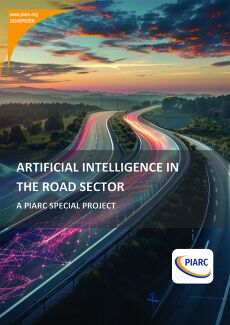
Artificial Intelligence (AI) is emerging as a transformative force in the road sector, offering substantial opportunities to improve safety, efficiency, and sustainability. Commissioned under PIARC's Special Projects programme, this study carried out by Roughan & O'Donovan Ltd., provides a comprehensive assessment of AI's current and future role in road infrastructure planning, design, construction, operation, and maintenance. The research findings are presented in two complementary documents: [...]
-
Rapid Impact Assessment in the Highway Sector
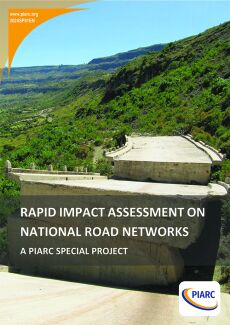
Most road networks around the world are impacted by natural and man-made hazards. Natural hazards are mostly climate- and geologically-induced, and landslides, debris flows, inland and coastal floods, earthquakes and drifting snow are among the most common. Man-made hazards include collisions and sabotage, for example, while forest fires can be sparked by extreme heat and careless or intentional ignition by the general public. The more severe of these hazards can impact large areas for long durations, [...]